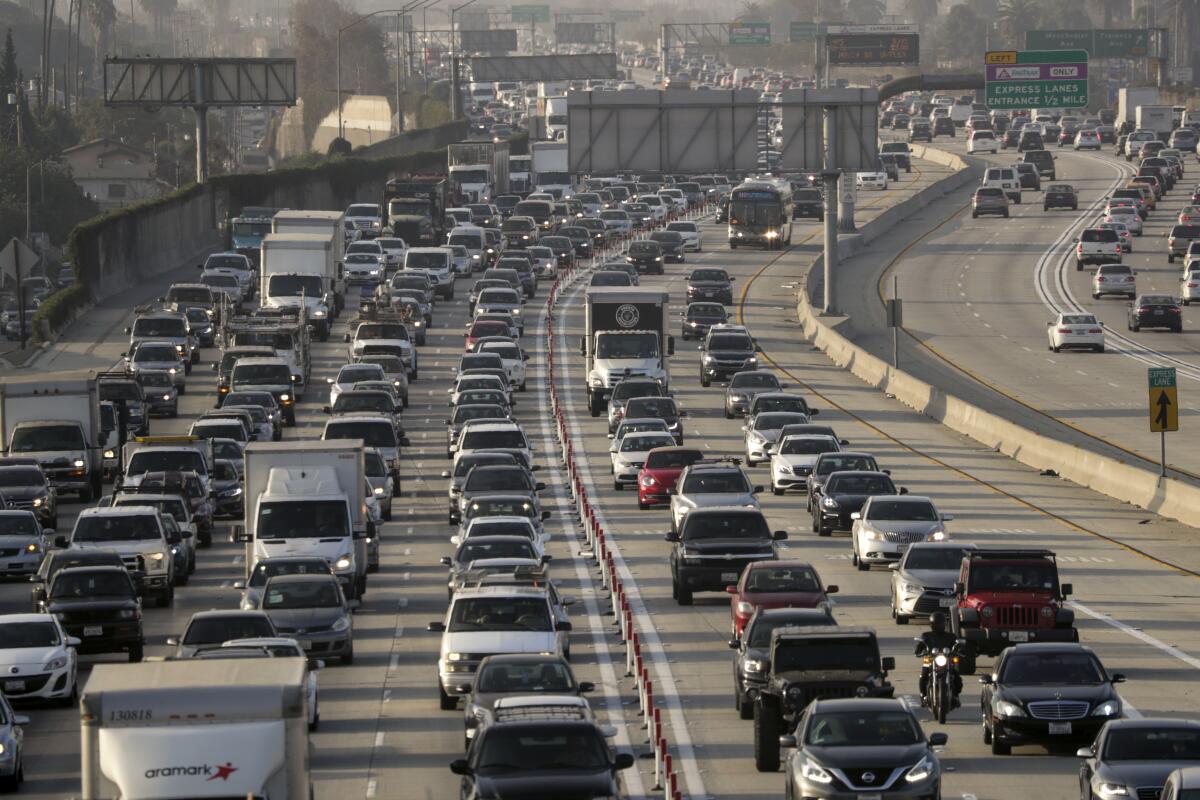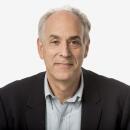What it would take to keep L.A. traffic from returning to soul-crushing levels

- Share via
Each morning I check the roads even though I’m not going anywhere.
Today my drive to work, if I had made it, would have taken 26 minutes, according to Google Maps. That’s about half of what it takes when I actually commute — when there’s no pandemic keeping me home. If traffic could just stay like this when the restrictions are lifted, I could save about 48 minutes a day, or four hours a week, or 200 hours a year.
Los Angeles, in normal times, is one of the country’s most traffic-clogged cities, home to the two most congested stretches of road — parts of the 5 and the 101 — and to a vast web of freeways that back up daily. The typical driver spent 103 hours stuck in traffic in 2019, according to Inrix, which specializes in transportation analytics.
But these days, as a result of the pandemic, which has shut down much of our economy, vehicle volume has been reduced by 40% and more in parts of the city. On average, L.A. traffic is moving 12% to 30% faster for those who are still driving. Air quality in Southern California is way up, according to EPA data, and auto collisions statewide are way down, according to a UC Davis survey.
Obviously, traffic is better today for all the wrong reasons: Hundreds of thousands of Angelenos have lost their jobs and millions of us are stuck in our homes avoiding the virus. No one wants that to continue. But just looking out, even from the window, on L.A.’s empty roads can’t help but raise the wistful question of whether, when the economy eventually reopens, there’s a way to keep the traffic flowing smoothly.
Answer: Probably not.
For years, L.A. has fought to get people off the roads and out of their cars with little success.
We’ve raised our own taxes by billions of dollars to improve mass transit, including adding bus routes and building new rail lines. We’ve constructed new housing near public transit with the hope that people will opt for subways and buses as the system becomes more comprehensive, appealing and reliable. But in recent years, transit use has declined rather than increased, and with fears of virus contagion it doesn’t seem likely that trend will reverse itself any time soon.
We’ve built HOV lanes to encourage carpooling, although they get mixed reviews from drivers. We’ve added extra freeway lanes — but under what’s known as “the fundamental law of road congestion” they get full as fast as we build them. We’ve got Sig alerts warning us of problems ahead and Waze offering us alternate routes. But we’re still stuck.
It’s frustrating because transportation experts say that even a relatively small decrease in the number of cars on the road would significantly reduce congestion. So what else is out there? Hawaii experimented with having public sector employees start work at staggered hours, but abandoned the idea because the mandatory program proved disruptive and inconvenient to peoples’ lives. Some cities have required deliveries to be made before 8 a.m., to reduce truck traffic.
Tom Vanderbilt, author of “Traffic: Why We Drive the Way We Do,” says maybe the pandemic will allow for a “window of experimentation” for Los Angeles — because research has found that the time to change habitual behavior is when habits have been interrupted.
“The collapse of the Embarcadero freeway in San Francisco [in 1989] achieved what politicians could not: a demonstration that urban freeways were neither desirable nor necessary,” says Vanderbilt. “When cars flooded New York after Hurricane Sandy knocked out the subway system, people quickly adapted to a three-passenger carpool requirement.”
One hope might be that the experience of the last six weeks has taught employers that it really is possible to keep a business running without requiring everybody to drive to the office every day.
But when I ran that idea by Genevieve Giuliano, a transportation expert at USC’s Sol Price School of Public Policy, I got only a cautious “I’ll be very curious to see what happens.”
Martin Wachs, a professor emeritus of engineering and city planning at UCLA, also seemed unpersuaded. He says there’s only one proven way to get people to drive less: ”The only strategy that works 100% of the time is charging people more money,” he says. “Charge more to park, charge to drive, quadruple the cost of gasoline, impose congestion pricing.”
Congestion pricing exists in London, Stockholm and Singapore. L.A. Metro is studying it here. We have a limited form of it already, with the pay-to-use lanes on sections of the 110 and 10 freeways. And last year, the Southern California Assn. of Governments suggested that a $4 fee to drive into a 4.3-square-mile portion of west Los Angeles could reduce traffic delays there by more than 20% at rush hour. The money raised from congestion pricing can be used to pay for transportation improvements generally, or, more specifically, for mass transit.
But politicians haven’t fully embraced congestion pricing because, in the end, they don’t believe their constituents want it. We could clear the traffic jams in the Sepulveda Pass by charging people $10 to make the trip, Wachs points out — but who would support that? Instead, we live with the congestion because, although we hate it, we prefer it to the alternative.
Without strong incentives, changing behavior is not easy. Giuliano pointed to Carmageddon in 2011, when parts of the 405 were closed down; to the Northridge earthquake of 1994, after which the 10 and the 5 suffered closures for months; and to the 1984 Olympics in L.A., when the city took dramatic steps to reduce driving. In each case, she said, traffic was markedly reduced, proving that L.A. can function with fewer cars on the roads. But each time, traffic surged back to normal afterward.
Apparently neither the soul-crushing traffic nor the cataclysmic threat of global climate change is enough to convince us to change our behavior. So, make good use of the extra time in your day while you have it. It’s not likely to last.
@Nick_Goldberg
More to Read
A cure for the common opinion
Get thought-provoking perspectives with our weekly newsletter.
You may occasionally receive promotional content from the Los Angeles Times.







